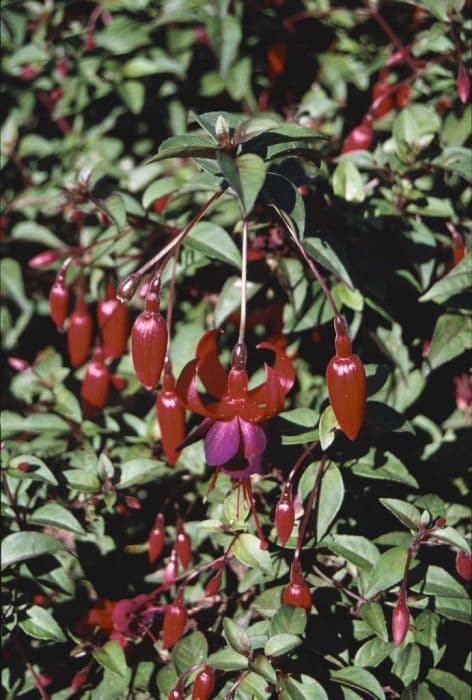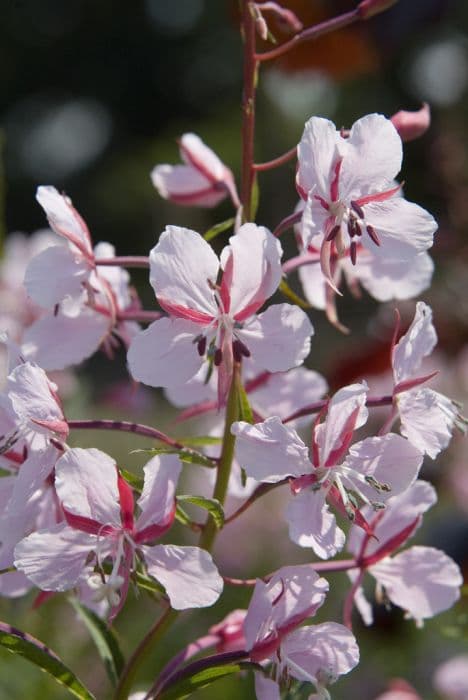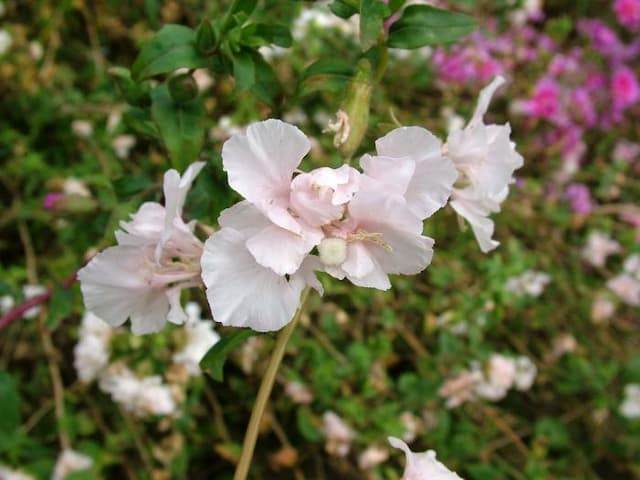Fuchsia Fuchsia 'Brutus'

ABOUT
Fuchsia 'Brutus' is known for its striking appearance, characterized by a vivid display of teardrop-shaped flowers that dangle elegantly from its branches. The blooms exhibit a deep pink to purple color with long, delicate petals that flare out gracefully from the top, often revealing a softer pink or white interior with a pronounced, slightly ballooning skirt. These flowers are contrasted against dark green foliage, with leaves that are oval or elongated in shape, presenting a slightly serrated edge that adds texture to the overall aesthetic. The combination of the dark foliage and the bright, richly-colored flowers creates a compelling visual contrast that is quite eye-catching. The plant bears its blooms abundantly, and they are known for their longevity, often lasting throughout the growing season, which adds to the plant's ornamental value. The Fuchsia 'Brutus' may also feature purple to pinkish veins, adding depth and intricacy to its flowers. This variety's overall appearance is one of cascading elegance, making it a popular choice for hanging baskets or as a feature in a garden where its showy flowers can be displayed to full effect.
About this plant
 Names
NamesSynonyms
Hardy Fuchsia, Lady's Eardrops, Fuchsia.
Common names
Fuchsia 'Brutus'.
 Toxicity
ToxicityTo humans
Fuchsias, in general, are not considered toxic to humans. However, sensitive individuals might experience mild digestive discomfort if ingesting parts of Fuchsia 'Brutus' or any other fuchsia plant. Symptoms could include nausea, vomiting, or diarrhea. Eating large amounts is not recommended due to the possible gastrointestinal upset.
To pets
Fuchsia plants, including Fuchsia 'Brutus', are also not considered toxic to pets. They are generally regarded as safe for dogs, cats, and horses. If a pet were to eat parts of a fuchsia plant, they might experience mild gastrointestinal upset, but serious symptoms or long-term health consequences are unlikely.
 Characteristics
CharacteristicsLife cycle
Perennials
Foliage type
Deciduous
Color of leaves
Green
Flower color
Mixed
Height
1-2 feet (30-60 cm)
Spread
1-2 feet (30-60 cm)
Plant type
Shrub
Hardiness zones
9
Native area
Central America
Benefits
 General Benefits
General Benefits- Ornamental Value: Fuchsia 'Brutus' is known for its striking appearance with its striking blossoms that add aesthetic value to gardens and landscapes.
- Attracts Pollinators: The flowers of Fuchsia 'Brutus' attract hummingbirds and butterflies, promoting biodiversity in the garden.
- Shade Tolerance: This plant can thrive in partial shade, making it a versatile choice for gardeners with shaded areas.
- Continuous Blooming: Fuchsia 'Brutus' has a lengthy blooming period, offering color and interest from spring to fall.
- Hanging Baskets: It is particularly well-suited for hanging baskets and containers, adding vertical interest to patios and porches.
- Variety of Uses: Can be used in a variety of garden settings, including borders, beds, and as a focal point due to its beautiful and unique flowers.
- Easy Propagation: Fuchsia 'Brutus' can be easily propagated from cuttings, allowing gardeners to multiply their plants without additional cost.
 Medical Properties
Medical PropertiesThis plant is not used for medical purposes.
 Air-purifying Qualities
Air-purifying QualitiesThis plant is not specifically known for air purifying qualities.
 Other Uses
Other Uses- Insect Attraction: Fuchsia 'Brutus' can be used in gardens to attract beneficial insects such as bees and butterflies, which are important for pollination.
- Natural Dye: The vibrant flowers and berries of the Fuchsia 'Brutus' may be used to create a natural dye for fabrics or art projects.
- Culinary Garnish: The edible flowers of the Fuchsia 'Brutus' provide an unusual and colorful garnish for salads, desserts, and cocktails.
- Educational Tool: This plant can be used in educational settings to demonstrate plant growth, flower structure, and botany to students.
- Photography Subject: The striking appearance of Fuchsia 'Brutus' makes it a popular subject for photographers, especially those specializing in botanical and macro photography.
- Horticultural Training: Fuchsia 'Brutus' is often used in horticultural colleges for training students in pruning techniques and plant care due to its specific growth requirements.
- Living Gifts: Potted specimens of Fuchsia 'Brutus' can be given as gifts that provide a long-lasting alternative to cut flowers.
- Theme Gardens: This plant is ideal for inclusion in "Victorian" or "cottage" garden themes due to its traditional popularity and historical associations.
- Wildlife Shelter: Fuchsia 'Brutus' shrubs can provide shelter and breeding sites for small birds and other wildlife within a garden setting.
- Bonsai Crafting: Some enthusiasts use Fuchsia 'Brutus' for bonsai because of its interesting branch structure and the challenge it presents in maintaining its form on a miniature scale.
Interesting Facts
 Feng Shui
Feng ShuiThe Fuchsia is not used in Feng Shui practice.
 Zodiac Sign Compitability
Zodiac Sign CompitabilityThe Fuchsia is not used in astrology practice.
 Plant Symbolism
Plant Symbolism- Confiding Love: Fuchsia is often associated with heartfelt confessions and a trustful revelation of feelings.
- Gentility: The elegant and delicate appearance of the fuchsia plant symbolizes grace and good taste.
- Humility: The way the fuchsia flower hangs down has been interpreted as a symbol of humility and modesty in one's achievements or beauty.
- Good Taste: The unique beauty and vibrant colors of the fuchsia represent a sense of refinement and good judgment in aesthetic matters.
- Ardent Affection: The richness of the fuchsia's colors is also representative of deep and passionate affection towards someone.
 Water
WaterFuchsias, including the variety 'Brutus', prefer consistently moist soil without being waterlogged. Water the plant when the top inch of soil feels dry to the touch, usually about twice a week, but this can vary based on temperature and humidity. Use lukewarm water to gently soak the soil until water begins to drain from the bottom of the pot. An average-sized fuchsia may require roughly 16-24 ounces of water per watering session during active growth periods in spring and summer, decreasing to 8-16 ounces in the cooler, dormant months.
 Light
LightFuchsias like 'Brutus' thrive in bright, indirect light. They should be placed in a spot where they receive morning sunlight and afternoon shade, as too much direct sunlight can lead to leaf scorch. The ideal location would be in an east- or north-facing position, where the light is diffused and softer.
 Temperature
TemperatureFuchsias, including 'Brutus', prefer a cool climate with temperatures ranging from about 60 to 75 degrees Fahrenheit. They can tolerate a few degrees cooler, but should not be subjected to temperatures below 50 degrees Fahrenheit or above 80 degrees Fahrenheit for extended periods as this can cause stress to the plant. The ideal temperature for fostering lush growth and bloom production is between 65 and 70 degrees Fahrenheit.
 Pruning
PruningPruning is essential for fuchsias like 'Brutus' to promote bushy growth and abundant flowers. Prune in the late winter or early spring before new growth begins, removing dead or weak stems and shaping the plant. Additionally, throughout the growing season, pinch back tips after flowering to encourage branching and more blooms. The best time for major pruning is either late winter or early spring, but maintenance pruning can be done as needed.
 Cleaning
CleaningAs needed
 Soil
SoilFuchsia 'Brutus' prefers a well-draining soil mix with peat, perlite, and loam in equal parts. The soil pH should be slightly acidic to neutral, ranging from 6.0 to 7.0 for optimal growth.
 Repotting
RepottingFuchsia 'Brutus' should be repotted annually to refresh the soil and accommodate growth. Repotting is best done in spring before new growth begins.
 Humidity & Misting
Humidity & MistingFuchsia 'Brutus' thrives at a humidity level of around 60-70%. They prefer a moist environment but not wet, making misting a beneficial practice for increasing humidity.
 Suitable locations
Suitable locationsIndoor
Place in bright, indirect light with high humidity.
Outdoor
Hang in partial shade, shelter from strong winds.
Hardiness zone
9-11 USDA
 Life cycle
Life cycleThe life cycle of Fuchsia 'Brutus', commonly known as Hardy Fuchsia, begins with seed germination, which takes place in warm, moist soil conditions, usually in late winter or early spring. Following germination, the seedlings emerge and develop into young plants with distinctive fuchsia foliage and begin to form a strong root system. As the plant matures, it enters the vegetative growth stage, where it produces a bushy structure with abundant leaves and stems in preparation for flowering. During the flowering stage, typically in late spring to summer, Hardy Fuchsia produces pendulous, teardrop-shaped flowers that are rich in color, often in shades of pink, purple, and red. After pollination, usually by hummingbirds or insects, the flowers develop into small, dark purple fruits that contain numerous tiny seeds. As temperatures drop in late autumn, Hardy Fuchsia enters a dormancy period where growth slows down or stops entirely, and the plant may die back, especially in colder climates, to re-emerge in the following spring.
 Propogation
PropogationPropogation time
Spring-Early Summer
The most popular method of propagation for Fuchsia 'Brutus', commonly known as Fuchsia, is via softwood cuttings. This process usually takes place in late spring to early summer when the plant is actively growing. To propagate, one should select healthy, non-flowering shoots of about 2 to 4 inches (approximately 5 to 10 centimeters) in length. The chosen cuttings should then have the lower leaves removed and be dipped in rooting hormone powder to enhance root development. Afterward, the cuttings are planted in a mixture of peat and perlite or sand to provide adequate drainage. They should be kept in a moist environment with high humidity and indirect light until roots develop, usually within a few weeks. Once rooted, cuttings can be transferred to individual pots and gradually acclimatized to normal growing conditions.









